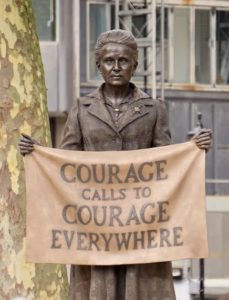Every day tourists mill around Parliament Square in front of Big Ben. Sometimes the selfies stop as placard-waving protestors invade the green, hollering at politicians inside the Palace of Westminster.
But, the statues in their midst remain unmoved by all the commotion.
Twelve effigies line the square – memorials to the great and the good who steered the course of history. Winston Churchill, David Lloyd George, Abraham Lincoln…
And until this year, they all had something in common. Every single one was a man.
A lack of diversity not lost on feminist campaigner Caroline Criado Perez. Out jogging on International Women’s Day, she clocked this gender imbalance, and wasn’t going to let it lie. Blood still boiling, Caroline started an online petition.
 The recent unveiling of the eight foot bronze statue of suffragist Millicent Fawcett a direct result of her post-run anger. The first of a woman, by a woman, to be erected in this iconic location.
The recent unveiling of the eight foot bronze statue of suffragist Millicent Fawcett a direct result of her post-run anger. The first of a woman, by a woman, to be erected in this iconic location.
An intellectual, writer, and activist. Millicent was instrumental in securing voting rights for women over 30 in the Representation of the People Act 1918. Her statue holds a banner bearing the words:
“Courage calls to courage everywhere”.
A quote from her speech given in the wake of the death of Emily Davison, the Suffragette infamously trampled by the king’s horse at the Derby in 1913. And 100 years after the first limited voting rights for British women, it’s certainly a start.
Consider that less than 3% of statues in Britain depict women not blessed by the privilege of royalty. And you get a sense of the scale of underrepresentation. Much like British boardrooms, that still smack of an old boys’ club.
Rewind to 2011 and the Davies report, and we had a step in the right direction – voluntary targets for female representation. The thinking behind it was simple:
Corporate boards perform better when there’s a broader range of perspectives and backgrounds.
True that.
25% by 2015 has been and gone, and now 33% by 2020 is the aim. But, what’s the verdict so far?
“Could do better” reads the midterm report.
Yes, progress has been made, but there’s still a long, long way to go. Frame it in global terms and the UK lags behind more progressive countries like Norway and France. And to meet the latest target, companies need to appoint women to 40% of their board positions over the next two years.
A big ask given the pace of change.
In our latest webinar, Women in the Boardroom – The Invisible Challenges, we looked at the barriers ambitious women hit up against, and what we can do to shake up the status quo.
1. What are the invisible challenges that stop women applying for executive positions?
2. What does it take to be ready for the C-suite?
3. Beyond personal belief, developing a growth mindset.
Forewarned is forearmed. Ready to recalibrate your mindset to achieve your full potential?
Speak to OnTrack today, to learn how we can help your organisation. info@ontrackinternational.com



